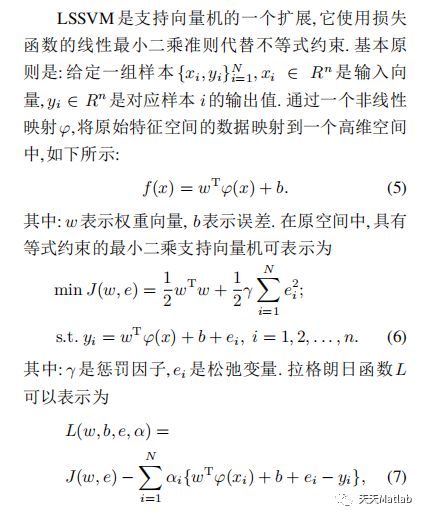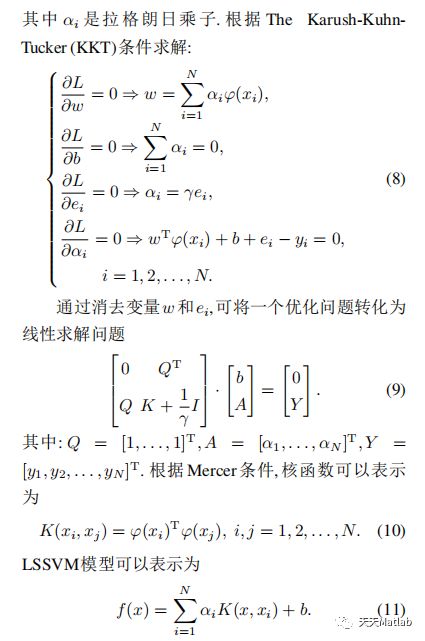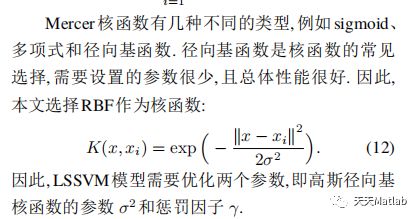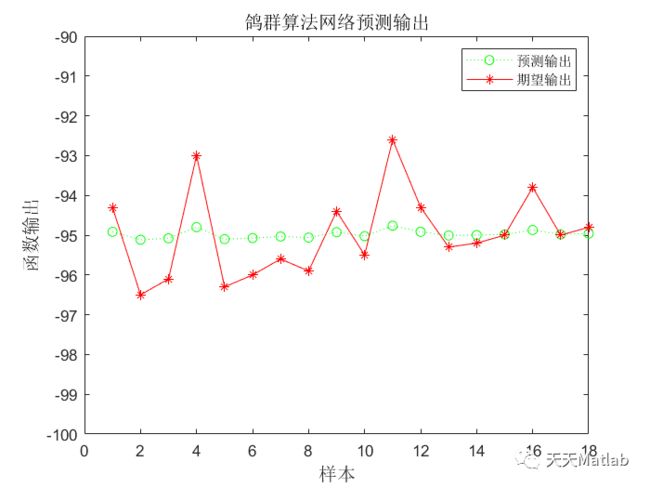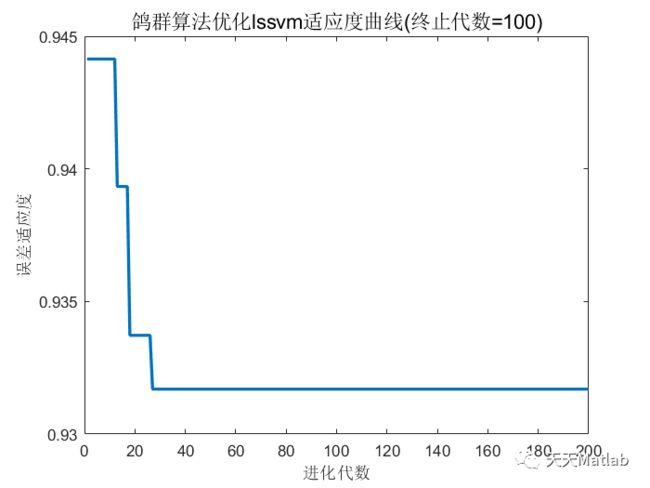【lssvm回归预测】基于鸽群算法优化最小二乘支持向量机PIO-lssvm实现数据回归预测附matlab代码
✅作者简介:热爱科研的Matlab仿真开发者,修心和技术同步精进,matlab项目合作可私信。
个人主页:Matlab科研工作室
个人信条:格物致知。
更多Matlab仿真内容点击
智能优化算法 神经网络预测 雷达通信 无线传感器
信号处理 图像处理 路径规划 元胞自动机 无人机 电力系统
⛄ 内容介绍
LSSVM 模型中的参数选择对模型的影响较大,采用鸽群优化算法进行模型参数的全局选优,用历史负荷数据和天气气象因素作为输入,建立优化电力负荷预测模型进行仿真.利用 PIO- LSSVM 模型对华东某市电力负荷进行验证分析.实验结果表明:鸽群算法优化的LSSVM 模型相比 LSSVM 具有更高的预测精度.
⛄ 部分代码
function [Best_vulture1_F,Best_vulture1_X,convergence_curve]=PIO(pigeonnum,max_iter,lower_bound,upper_bound,D,fobj);
%%####A new bio-inspired swarm intelligence optimizer ?C pigeon inspired
%%####optimization (PIO) is presented by simulating pigeons homing
%%####behaviors. Homing pigeons can easily find their homes by using
%%####three homing tools: magnetic field, sun and landmarks. In this
%%#### newly invented algorithm, map and compass operator model is
%%#### presented based on magnetic field and sun, while landmark operator
%%#### model is presented based on landmarks. For some tough functions,
%%#### it can quickly find the optimum, and it performs powerfully. For the
%%#### most important reason, it combines some advantages of algorithms
%%#### such as particle swarm optimization and artificial fish school algorithm.
%***************initialization*******************
T1=max_iter; %Global search algebra
T2=max_iter; %Local search algebra
% pigeonnum=30; %number
% D = 30; % dimensionality
R=0.3; %parameters of magnetic field
bound=[lower_bound,upper_bound]; %hunting zone
tol = 1e-7;
%**************initialization of the individual pigeon************
for i=1:pigeonnum %时间复杂度O(pigeonum*D*2)
for j=1:D
x(i,j)=bound(1)+rand*(bound(2)-bound(1));
v(i,j)=rand;
end
end
%**************calculate the fitness of pigeon***********
for i=1:pigeonnum %时间复杂度O(pigeonum*2)
p(i)=fobj(x(i,:));
p_best(i,:)=x(i,:);
end
%**************find the optimal pigeons********************
g_best=x(1,:);
for i=2:pigeonnum %时间复杂度O(pigeonum-1)
if fobj(g_best)>fobj(x(i,:))
g_best=x(i,:);
end
end
%************ magnetic compass and solar operator********************
for t=1:T1 %时间复杂度O(T1*(pigeonum*(2D+5))+1)
for i=1:pigeonnum %时间复杂度O(pigeonum*(2D+5))
v(i,:)=v(i,:)+rand*(p_best(i,:)-x(i,:));
x(i,:)=x(i,:)*(1-exp(-R*t))+v(i,:); %check whether beyond the searching space
for j=1:D % magnetic field and solar operator
if abs(i-1)<=eps
if x(i,j)
x(i,j)=bound(1)+rand*(bound(2)-bound(1));
v(i,j)=rand;
end
else
if x(i,j)
x(i,j)=x(i-1,j);
v(i,j)=v(i-1,j);
end
end
end
if fobj(x(i,:)) p(i)=fobj(x(i,:)); p_best(i,:)=x(i,:); end if p(i) g_best=p_best(i,:); end end result(t)=fobj(g_best); end %*************???????********************** for t=1:T2 %时间复杂度O(T2*pigeonum*pigeonum) for i=1:pigeonnum-1 %sort the pigeons for j=i+1:pigeonnum if fobj(x(i,:))>fobj(x(j,:)) temp_pigeon=x(i,:); x(i,:)=x(j,:); x(j,:)=temp_pigeon; end end end pigeonnum=ceil(pigeonnum/2); %remove half of the pigeons according to the landmark addpigeonnum=0; for i=1:pigeonnum addpigeonnum=addpigeonnum+x(i,:); p(i)=fobj(x(i,:)); %calculate fitness and location of the pigeon after sorting p_best(i,:)=x(i,:); end pigeoncenter=ceil(addpigeonnum./pigeonnum);%calculate central position for i=1:pigeonnum %local searching for j=1:D %check whether beyond the searching space x(i,j) = x(i,j) + rand*(pigeoncenter(j)-x(i,j)); while x(i,j) x(i,j) = x(i,j) + rand*(pigeoncenter(j)-x(i,j)); end end if fobj(x(i,:)) p(i)=fobj(x(i,:)); p_best(i,:)=x(i,:); end if p(i) g_best=p_best(i,:); end end result(t+T1)=fobj(g_best); end % figure %graph % for t=1:T1+T2-1 % plot([t,t+1],[result(t),result(t+1)]); % hold on; % end % xlabel('Iterative curve'); % ylabel('Function value'); % title(['The best value is ' num2str()]) [Best_vulture1_F,indx]=min(result); Best_vulture1_X=g_best; convergence_curve=result; end [1]鞠彬王嘉毅. 基于粒子群算法与最小二乘支持向量机的ET0模拟[J]. 水资源保护, 2016, 32(4):74-79. [2]吴文江, 陈其工, and 高文根. "基于 PSO 优化参数的最小二乘支持向量机短期负荷预测." 重庆理工大学学报(自然科学版) 030.003(2016):112-115. ❤️部分理论引用网络文献,若有侵权联系博主删除 ❤️ 关注我领取海量matlab电子书和数学建模资料⛄ 运行结果
⛄ 参考文献
⛄ Matlab代码关注
